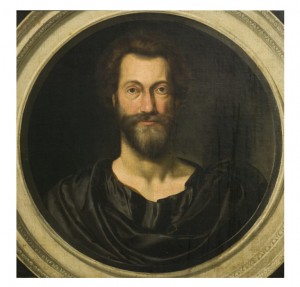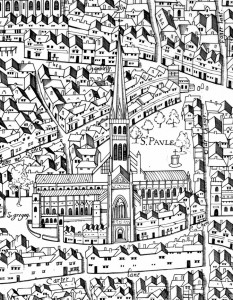The purpose of “Virtual Paul’s Cross Project” is to visualize a quite important historical event, namely, John Donne’s sermon for Gunpowder Day, November 5, 1622. From 16th century, the Church of England, with the English Roy alty at its head, had kept trying to achieve full power (political and religious authority) on controlling the country. John Donne’s sermon for Gunpowder Day publicly declared the British Crown’s (James’) religious authority by denying the Catholic church. Donne made the sermon at St. Paul’s Cross, by ST Paul’s Cathedral, which was later burnt by the Great Fire of London. “Virtual Paul’s Cross” rebuilds a place that only exists in history to us. Audiences are able to experience the infectiouness of the sermon not only from text but also from acoustic and visual scale.
alty at its head, had kept trying to achieve full power (political and religious authority) on controlling the country. John Donne’s sermon for Gunpowder Day publicly declared the British Crown’s (James’) religious authority by denying the Catholic church. Donne made the sermon at St. Paul’s Cross, by ST Paul’s Cathedral, which was later burnt by the Great Fire of London. “Virtual Paul’s Cross” rebuilds a place that only exists in history to us. Audiences are able to experience the infectiouness of the sermon not only from text but also from acoustic and visual scale.
The project reproduces the history site precisely. It is concerned with the churchyard, acoustics, weather and even the size of the crowd. To rebuild the churchyard, the
 contributors used contemporary paintings as important points of references on decorating, 16th century maps were also used as reference for the surrounding environment and internal dimensions sketched as reference on structuring. Researchers transcribed historical information and then translated it into data. Then they recombine the big data into the “real world”. Audiences can experience the precisely built
contributors used contemporary paintings as important points of references on decorating, 16th century maps were also used as reference for the surrounding environment and internal dimensions sketched as reference on structuring. Researchers transcribed historical information and then translated it into data. Then they recombine the big data into the “real world”. Audiences can experience the precisely built
environment in James B Hunt library. Projectors and virtual acoustics can send users back to the historical moment.
People regard films as living sculptures. This project should be a perfect example of living history. The large amount of information about the weather, the social influence or the shape of the old buildings can be presented to ordinary people by this project. They can enjoy going back into history experience without reading the big data and facts but experiencing it in a more intuitive way. However, for researchers, this project provides a different methodology for digging into old history. Interdisciplinary cooperation in this project connects and combines the research made by historicists, geologists and even computer scientists. For example, because the Paul’s churchyard is only able to contain 4000 people, when measuring the influence of this event, an architect in the group can point out this technical limitation (which might be a significant index) instead of only focusing on researching social environment by text (historicists did). 1+1 >2
Comments
One response to “Analysis of the Virtual Paul’s Cross Project”
Good work!